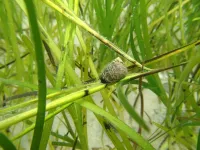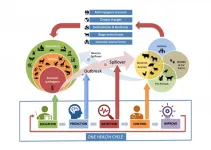(Press-News.org) Astronomers have identified more than 4,000, and counting, confirmed exoplanets -- planets orbiting stars other than the sun -- but only a fraction have the potential to sustain life.
Now, new research from UBC's Okanagan campus is using the geology of early planet formation to help identify those that may be capable of supporting life.
"The discovery of any planet is pretty exciting, but almost everyone wants to know if there are smaller Earth-like planets with iron cores," says Dr. Brendan Dyck, assistant professor of geology in the Irving K. Barber Faculty of Science and lead author on the study.
"We typically hope to find these planets in the so-called 'goldilocks' or habitable zone, where they are the right distance from their stars to support liquid water on their surfaces."
Dr. Dyck says that while locating planets in the habitable zone is a great way to sort through the thousands of candidate planets, it's not quite enough to say whether that planet is truly habitable.
"Just because a rocky planet can have liquid water doesn't mean it does," he explains. "Take a look right in our own solar system. Mars is also within the habitable zone and although it once supported liquid water, it has long since dried up."
That, according to Dr. Dyck, is where geology and the formation of these rocky planets may play a key role in narrowing down the search. His research was recently published in the Astrophysical Journal Letters.
"Our findings show that if we know the amount of iron present in a planet's mantle, we can predict how thick its crust will be and, in turn, whether liquid water and an atmosphere may be present," he says. "It's a more precise way of identifying potential new Earth-like worlds than relying on their position in the habitable zone alone."
Dr. Dyck explains that within any given planetary system, the smaller rocky planets all have one thing in common -- they all have the same proportion of iron as the star they orbit. What differentiates them, he says, is how much of that iron is contained in the mantle versus the core.
"As the planet forms, those with a larger core will form thinner crusts, whereas those with smaller cores form thicker iron-rich crusts like Mars."
The thickness of the planetary crust will then dictate whether the planet can support plate tectonics and how much water and atmosphere may be present, key ingredients for life as we know it.
"While a planet's orbit may lie within the habitable zone, its early formation history might ultimately render it inhabitable," says Dr. Dyck. "The good news is that with a foundation in geology, we can work out whether a planet will support surface water before planning future space missions."
Later this year, in a joint project with NASA, the Canadian Space Agency and the European Space Agency, the James Webb Space Telescope (JWST) will launch. Dr. Dyck describes this as the golden opportunity to put his findings to good use.
"One of the goals of the JWST is to investigate the chemical properties of extra-solar planetary systems," says Dr. Dyck. "It will be able to measure the amount of iron present in these alien worlds and give us a good idea of what their surfaces may look like and may even offer a hint as to whether they're home to life."
"We're on the brink of making huge strides in better understanding the countless planets around us and in discovering how unique the Earth may or may not be. It may still be some time before we know whether any of these strange new worlds contain new life or even new civilizations, but it's an exciting time to be part of that exploration."
INFORMATION:
Researchers at the University of North Carolina at Chapel Hill and Duke University improved HIV care by gamifying it with a mobile gaming application.
Gaming features - like those used to drive airline loyalty and track daily steps --- helped young men living with HIV achieve viral suppression and doubled their chances for reaching near perfect adherence to medication plans, according to a study in AIDS and Behavior.
Gamification can inspire changes in behavior when a doctor's advice or a patient's good intentions are not enough. In this case, motivating those living with HIV to stick to ...
Research funding agencies around the world are testing creative approaches to address urgent needs while laying the foundation for discoveries that will meet the unpredictable demands of the future. According to a new expert panel report from the Council of Canadian Academies (CCA), Canada can bolster its research capacity by reducing administrative burdens, experimenting with funding approaches, and cultivating a robust, resilient, and diverse scientific workforce.
"In the past year we have seen the power and promise of transformative research and the ability of researchers and funding organizations to pivot in times of crisis," said Shirley M. Tilghman, PhD, O.C., FRS, Chair of the Expert Panel. "But the pandemic has also exacerbated existing inequalities ...
Almost half of the parents who have children together with a parent with schizophrenia or bipolar disorder, are themselves burdened by psychological issues. This can affect family life and the children. This is shown in the research result from the major Danish psychiatry project iPSYCH.
We typically choose a partner who resembles us in relation to social status, education and, to some extent, also income. Research has previously established this. A new study now shows that almost half of the parents who have children with a partner who suffers from schizophrenia or bipolar disorder themselves meet the criteria for a mental disorder. By comparison, this is 18 percent for parents in the control group.
The results stem from The Danish High-Risk and Resilience ...
Aging is the biggest risk factor for perturbation of the nervous system, even in the absence of distinct disease or trauma. For yet unknown reasons, the impulse conducting, myelinated projections and synaptic connections between nerve cells are especially vulnerable to aging-related degeneration. These pathological alterations often manifest as cognitive, sensory, and motor decline in older adults and represent a serious socio-economic challenge.
Malactivation leads to damage
Scientists have long assumed that inflammation plays an important role in this process. Mal- or overactivation of distinct cells belonging to the innate immune system - the microglia - appears to promote damage of nerve fibers and synapses ...
As the digital revolution has now become mainstream, quantum computing and quantum communication are rising in the consciousness of the field. The enhanced measurement technologies enabled by quantum phenomena, and the possibility of scientific progress using new methods, are of particular interest to researchers around the world.
Recently two researchers at Tampere University, Assistant Professor Robert Fickler and Doctoral Researcher Markus Hiekkamäki, demonstrated that two-photon interference can be controlled in a near-perfect way using ...
For the first time, international experts in psychology have built a framework to diagnose Compulsive Buying-Shopping Disorder - promising help for people struggling to manage their spending behaviour and mental wellbeing.
The new guidelines, published in the Journal of Behavioral Addictions, confirms that excessive buying and shopping can be so serious as to constitute a disorder, giving researchers and clinicians new powers to develop more targeted interventions for this debilitating condition.
The international collaboration, led by Professor Mike Kyrios from Flinders University's Órama Institute for Mental ...
SINGAPORE - A team of researchers from the Agency for Science, Technology and Research's (A*STAR) Genome Institute of Singapore (GIS) and Bioprocessing Technology Institute (BTI), as well as Singapore Eye Research Institute (SERI), have identified a genetic mutation (functionally defective CYP39A1 gene) associated with exfoliation syndrome, the most common cause of glaucoma. The findings could pave the way for future research on the cause of exfoliation syndrome and potential cures. Their research was published in Journal of the American Medical Association (JAMA) on 24 February 2021.
Exfoliation syndrome is a systemic ...
Artificial intelligence that enhances remote monitoring of water bodies - highlighting quality shifts due to climate change or pollution - has been developed by researchers at the University of Stirling.
A new algorithm - known as the 'meta-learning' method - analyses data directly from satellite sensors, making it easier for coastal zone, environmental and industry managers to monitor issues such as harmful algal blooms (HABs) and possible toxicity in shellfish and finfish.
Environmental protection agencies and industry bodies currently monitor the 'trophic state' of water - its biological productivity - as an indicator of ecosystem health. Large clusters of microscopic algae, or phytoplankton, is called eutrophication and can ...
Mangroves and seagrasses grow in many places along the coasts of the world, and these 'blue forests' constitute an important environment for a large number of animals. Here, juvenile fish can hide until they are big enough to take care of themselves; crabs and mussels live on the bottom; and birds come to feed on the plants.
However, the plant-covered coastal zones do not only attract animals but also microplastics, a new study shows.
- The denser the vegetation, the more plastic is captured, says Professor and expert in coastal ecology, Marianne Holmer, from the University of Southern Denmark.
She is concerned about how the accumulated microplastics affect animal and plant life.
- We know from other ...
The EU-funded BIO-CRIME project - with support from the Leibniz Institute for Zoo and Wildlife Research (Leibniz-IZW) - conducted a scientific investigation on the topic of illegal small animal trade and the associated risk of pathogen transmission.
The study focused on the key areas of "illegal small animal trade" and the level of knowledge and proper behaviours of young people and adolescents with "zoonotic diseases" and the "One Health concept". One Health is an approach that recognises that human health is closely linked to the health of animals and our shared ...









